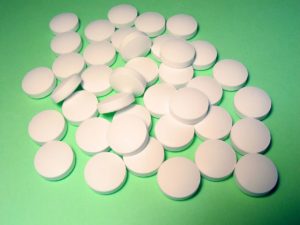 Very important research looking at some professional football players who started playing tackle football before the age of 12, and comparing them to those who started later. It discusses the issue of whether children should be playing tackle football before the age of 12 - these and other results suggest NOT. Wait till older (or don't play tackle at all).This article came from Boston University through Futurity:
Very important research looking at some professional football players who started playing tackle football before the age of 12, and comparing them to those who started later. It discusses the issue of whether children should be playing tackle football before the age of 12 - these and other results suggest NOT. Wait till older (or don't play tackle at all).This article came from Boston University through Futurity:
Is This Kid Too Young For Football?
Researchers from Boston University School of Medicine found that former National Football League (NFL) players who participated in tackle football before the age of 12 are more likely to have memory and thinking problems as adults.
The study contradicts conventional wisdom that children’s more plastic brains might recover from injury better than those of adults, and suggests that they may actually be more vulnerable to repeated head impacts, especially if injuries occur during a critical period of growth and development. "
“This is one study, with limitations,” adds study senior author Robert Stern, a professor of neurology, neurosurgery, and anatomy and neurobiology and director of the Alzheimer’s Disease Center’s Clinical Core. “But the findings support the idea that it may not make sense to allow children—at a time when their brain is rapidly developing—to be exposed to repetitive hits to the head.”
In the study, researchers reexamined data from Boston University’s ongoing DETECT(Diagnosing and Evaluating Traumatic Encephalopathy Using Clinical Tests) study, which aims to develop methods of diagnosing chronic traumatic encephalopathy (CTE) during life. CTE is a neurodegenerative disease often found in professional football players, boxers, and other athletes who have a history of repetitive brain trauma. It can currently be diagnosed only by autopsy.
For this latest study, published in the journal Neurology, scientists examined test scores of 42 former NFL players, with an average age of 52, all of whom had experienced memory and thinking problems for at least six months. Half the players had played tackle football before age 12, and half had not. Significantly, the total number of concussions was similar between the two groups.
Researchers found that the players exposed to tackle football before age 12 had greater impairment in mental flexibility, memory, and intelligence—a 20 percent difference in some cases. These findings held up even after statistically removing the effects of the total number of years the participants played football. Both groups scored below average on many of the tests.
Stamm says the researchers were especially surprised by the scores on a reading test called the WRAT-4, which has participants read words of increasing difficulty....The low scores may be significant, she says, because they suggest that repeated head trauma at a young age might limit peak intelligence. She emphasizes, however, that there may be other reasons for a low score, and that more research is needed.
The authors chose age 12 as the cutoff because significant peaks in brain development occur in boys around that age. (This happens for girls a bit earlier, on average.) Around age 12, says Stern, blood flow to the brain increases, and brain structures such as the hippocampus, which is critical for memory, reach their highest volume.
Boys’ brains also reach a peak in their rate of myelination—the process in which the long tendrils of brain cells are coated with a fatty sheath, allowing neurons to communicate quickly and efficiently. Because of these developmental changes, Stern says, this age may possibly represent a “window of vulnerability,” when the brain may be especially sensitive to repeated trauma.
Stern adds that a study by another group of researchers of the number and severity of hits in football players aged 9 to 12, using accelerometers in helmets, found that players received an average of 240 high-magnitude hits per season, sometimes with a force similar to that experienced by high school and college players.
With approximately 4.8 million athletes playing youth football in the United States, the long-term consequences of brain injury represent a growing public health concern. This study comes at a time of increasing awareness of the dangers of concussions—and subconcussive hits—in youth sports like football, hockey, and soccer. In 2012, Pop Warner football, the oldest and largest youth football organization in the country, changed its rules to limit contact during practices and banned intentional head-to-head contact.
“Football has the highest injury rate among team sports,” writes Christopher M. Filley, a fellow with the American Academy of Neurology, in an editorial accompanying the Neurology article. “Given that 70 percent of all football players in the United States are under the age of 14, and every child aged 9 to 12 can be exposed to 240 head impacts during a single football season, a better understanding of how these impacts may affect children’s brains is urgently needed.”

 This study is important because it shows (once again) that spatial skills may be developed by what a child does in childhood. The trend for girls to only be given dolls or stereotypically "girl" toys is not that good for mental development (but good for nurturing). All children need to play with blocks, puzzles, and to create and build. They all need to go out and actively explore their environment, which also is good for developing spatial reasoning skills (as shown by earlier research). Think about it: when you actively explore the streets and land around you, you develop "mental maps" of how to get around, and this is good for spatial skills. Bottom line: encourage
This study is important because it shows (once again) that spatial skills may be developed by what a child does in childhood. The trend for girls to only be given dolls or stereotypically "girl" toys is not that good for mental development (but good for nurturing). All children need to play with blocks, puzzles, and to create and build. They all need to go out and actively explore their environment, which also is good for developing spatial reasoning skills (as shown by earlier research). Think about it: when you actively explore the streets and land around you, you develop "mental maps" of how to get around, and this is good for spatial skills. Bottom line: encourage  This is great to hear for those younger and wondering about life for those in their 70s and 80s. A total of 6,201 people between 50 and 90 years old were surveyed in this study.From Science Daily:
This is great to hear for those younger and wondering about life for those in their 70s and 80s. A total of 6,201 people between 50 and 90 years old were surveyed in this study.From Science Daily: Finding an increased risk of dementia and Alzheimer's with so many common over-the-counter medications such as
Finding an increased risk of dementia and Alzheimer's with so many common over-the-counter medications such as